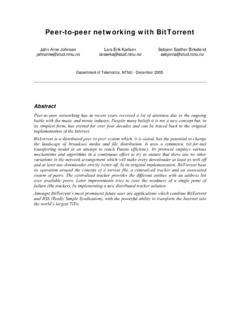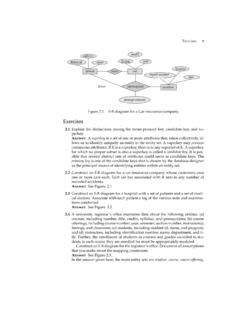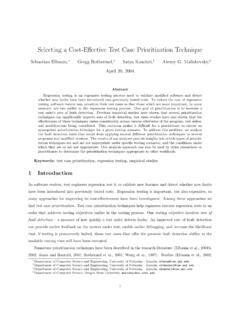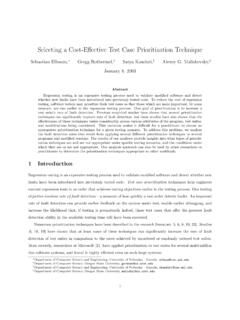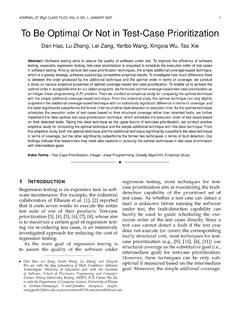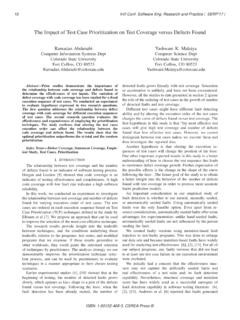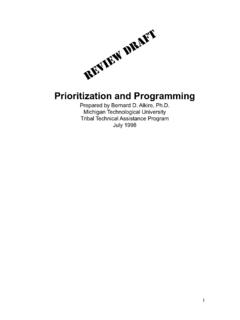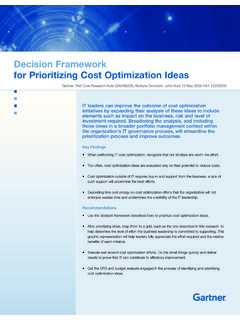Transcription of Prioritizing test cases for early detection of refactoring ...
1 SOFTWARE TESTING, VERIFICATION AND RELIABILITYS oftw. Test. Verif. ;26:402 426 Published online 21 March 2016 in Wiley Online Library ( ). DOI: test cases for early detection of refactoring faultsEverton L. G. Alves1,*, , Patr cia D. L. Machado1, Tiago Massoni1and Miryung Kim21 Federal University of Campina Grande Campina Grande, 58429-900, Brazil2 University of California Los Angeles, CA, 90095 USASUMMARYR efactoring edits are error-prone, requiring cost-effective testing. Regression test suites are often usedas a safety net for decreasing the chances of behavioural changes. Because of the high costs related tohandling massive test suites, prioritization techniques can be applied to reorder test case execution, fos-tering early fault detection .
2 However, traditional prioritization techniques are not specifically designed fordetecting refactoring -related faults. This article proposes refactoring -based approach (RBA), a refactoring -aware strategy for Prioritizing regression test cases . RBA reorders an existing test sequence, using a set ofproposed refactoring fault models that define the refactoring s impact on program approach s evaluation shows that it promotes early detection of refactoring faults andoutperforms well-known prioritization techniques in 71% of the , it prioritizes fault-revealing test cases close to one another in 73% of the cases , which can beuseful for fault localization. Those findings show that RBA can considerably improve prioritization of testcases during perfective evolution, both by increasing fault- detection rates as well as by helping to pinpointdefects introduced by an incorrect refactoring .
3 Copyright 2016 John Wiley & Sons, 10 September 2014; Revised 13 February 2016; Accepted 24 February 2016 KEY WORDS:test case prioritization ; refactoring ; automated software testing1. INTRODUCTIONR efactoringsaim to improve the internal aspects of a program while preserving its externalbehaviour [1, 2]. refactoring edits are very common in software development; Xing and Stroulia[3] report almost 70% of all structural changes in Eclipse s history are refactoring related. Recentstudies find software quality gains due to refactoring . Kimet al. analysis on Windows 7 versions [4]shows a significant reduction of inter-module dependencies and post-release defects in refactoredmodules.
4 Moreover, Investigation of MacCormacket al. with the evolution of Mozilla s architecture[5] detects a significant improvement after continuous popular IDEs include built-in refactoring tools, developers still perform most refac-torings manually. Murphyet al. [6] find that about 90% of refactoring edits are manually al. [7] show that expert developers prefer manual refactoring over automated. The under-use of refactoring tools is mostly due to usability issues, to the lack of trust, and to developer sunawareness [8, 9]. Moreover, recent studies have shown that even well-known refactoring tools arenot free of problematic refactorings [10, 11].As subtle faults may pass unnoticed, either manual or automatic refactorings require subtle faults, we mean edits that alter a program s behaviour without generating compilationerrors.
5 Diget al. [12] state that nearly 80% of the changes that break client applications are API-levelrefactoring edits. Studies using version histories find that there is a relationship between the number*Correspondence to: Everton, L. G. Alves, Federal University of Campina Grande, Campina Grande, 58429-900, Brazil. E-mail: 2016 John Wiley & Sons, TEST cases FOR early detection OF refactoring FAULTS403of refactorings and software bugs [13, 14]. In addition, 77% of the participants from the survey ofKimet al. with Microsoft developers [4] confirm that refactoring may induce the introduction ofsubtle bugs and functionality number of strategies are designed to prevent behavioural changes when refactoring : (i)refac-toring mechanics, proposed by Fowler [1], guide the application of refactoring with the combinationof micro changes and compilation/test checks; (ii)the formal specification of refactoring edits,founded by theories of object-oriented programming [15 17]; (iii) refactoring engines, automatethe application of refactoring edits by checking pre-conditions ( Eclipse , NetBeans ,JRRT ).
6 And (iv)regression testing, test suites are used to increase confidence on behaviour preservation afterrefactoring [18].From those options, regression testing is probably the most popular alternative. However, as asystem evolves, its regression test suite tends to increase, because new test cases can be added tocheck new functionalities [19, 20]. Thus, it may be impractical to rerun regression suites after eachrefactoring when working with a large test suite it can take a long time for the first test case tofail as well as it may be difficult and costly to gather enough information on test cases that fail sothat fault localization can begin. In such context, there is a need for techniques that preserve testeffectiveness, with as few test cases as possible.
7 Test case prioritization [21] rearranges a test suiteaiming to improve achievement of certain testing goals ( the rate of fault detection ). Severalprioritization techniques have been proposed [22 28]; most consider code coverage as prioritizationcriteria [21] some are detailed in Section 3, and thoroughly in Section general-purpose (or traditional) solutions might produce acceptable results, specificproblems may require particular and/or adaptive solutions [29 33]. In previous empirical studies[34 36], we investigate how traditional general-purpose techniques behave when dealing withseeded refactoring faults in the context of real-open source projects. This investigation shows thatthose techniques perform poorly when aiming to anticipate the detection of refactoring faults fault-revealing test cases were placed in the top of the prioritized suite only in 35% of the cases (Section 2 exemplifies such scenarios).
8 Traditional prioritization approaches lack useful informationfor better scheduling test cases that detect refactoring faults. To the best of our knowledge, thereis no prioritization technique specialized in refactoring fault detection . This article proposes therefactoring-based approach(RBA), a technique for Prioritizing test cases guided by refactoringedits. This technique s prioritization heuristic assumes that a test case is more likely to detect a refac-toring problem if it covers the locality of the edits, and/or commonly impacted methods. In orderto relate possibly impacted methods to test cases , refactoring fault models(RFMs) for five commonrefactoring types were defined (rename method, move method, pull up field, pull up method and addparameter) [6, 7].
9 Those models identify the commonly impacted methods after a specific refactor-ing. The preliminary ideas behind RBA are introduced in a previous workshop paper [34], whilethis article extends the solution with a complete definition of RFMs and a broader approach is evaluated by means of two empirical studies: a case study usingthree real-open source projects (EasyAccept, JMock and XML-Security) with seeded refactoringfaults and a controlled experiment using subtle refactoring faults collected from related studies andextensive test suites. In comparison with six well-known prioritization techniques [37, 38], RBAsuccessfully detects refactoring faults earlier than all traditional prioritization techniques in mostcases (71%).
10 Studies in the literature show that prioritization techniques can impact fault localization effective-ness, particularly if a selection of ranked test cases does not provide enough information to pinpointfaults [39 42]. The reason is that fault localization techniques may not produce good results if thesuite has mostly passing tests [42].Thus, RBA is also investigated regarding how spread the fault-revealing test cases are. By spread,we mean how distant from one another, in the prioritized sequence, the test cases that reveal faultsare. The evaluation shows that RBA provides orders with more narrowly spread test cases in 73% 2016 John Wiley & Sons, Test. Verif. ;26:402 426 DOI: L.







